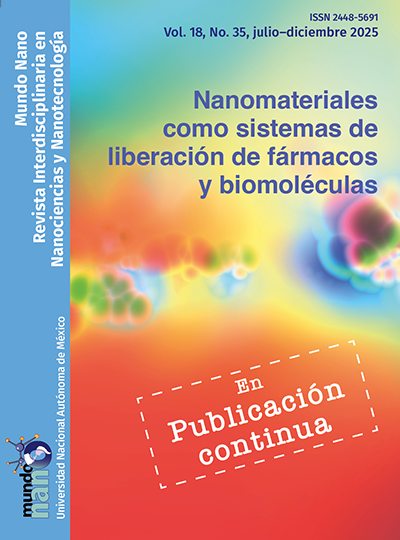Influencia del grado de desacetilación del quitosano en la síntesis de nanopartículas para aplicaciones farmacéuticas
Contenido principal del artículo
Resumen
El quitosano es un biopolímero versátil con aplicaciones en nanotecnología, de amplio interés en la síntesis de nanopartículas para administración de fármacos. Su grado de desacetilación (DD, por sus siglas en inglés) es un parámetro clave que influye en las propiedades de las nanopartículas tales como carga superficial, tamaño, y estabilidad coloidal. Sin embargo, su impacto en la funcionalidad de las nanopartículas aún requiere de un análisis detallado. El objetivo de este estudio fue explorar la relación entre el DD del quitosano y sus propiedades fisicoquímicas en la síntesis de nanopartículas, así como sus implicaciones en aplicaciones farmacéuticas. Para ello se realizó una revisión de la literatura en las bases de datos PubMed, Google Scholar y ScienceDirect, utilizando las palabras clave chitosan, deacetylation y nanoparticles, tanto en inglés como en español. Estas palabras clave se identificaron en los títulos y resúmenes de artículos de investigación. Se incluyeron estudios publicados entre el año 2000 y el 2025, abordando la síntesis, modificación o caracterización de nanopartículas de quitosano. Se excluyeron estudios sin reportar explícitamente el DD y su relación con propiedades funcionales o aplicaciones biomédicas, así como publicaciones duplicadas. Los resultados evidencian que un DD medio (70-85%) promueve una adecuada interacción con membranas celulares, común en aplicaciones farmacéuticas. Un DD bajo (< 70%) implica una menor interacción con membranas biológicas, por lo que tienen limitada utilidad en sistemas de liberación. Aunque un DD alto (86-95%) podría promover mayor adhesión a superficies celulares y mayor eficiencia de encapsulación, también pueden promover alta reactividad y posible citotoxicidad por su densidad de grupos amino libres. No obstante, un DD muy alto (> 95%) podría causar toxicidad, además de reducir la viscosidad, afectando la estabilidad de las formulaciones. Estos hallazgos subrayan la necesidad de ajustar el DD según la aplicación específica, optimizando la funcionalidad de las nanopartículas de quitosano. En conclusión, el control preciso del DD es esencial para maximizar el potencial del quitosano para la preparación de nanopartículas destinadas a la administración de fármacos. Además, futuros estudios deben enfocarse en la estandarización de métodos de producción de quitosano con grados de desacetilación específicos, y en su aplicación en nuevas terapias nanotecnológicas.
Descargas
Detalles del artículo

Mundo Nano. Revista Interdisciplinaria en Nanociencias y Nanotecnología, editada por la Universidad Nacional Autónoma de México, se distribuye bajo una Licencia Creative Commons Atribución-NoComercial 4.0 Internacional.
Basada en una obra en http://www.mundonano.unam.mx.
Citas
Abourehab, M. A. S., Pramanik, S., Abdelgawad, M. A., Abualsoud, B. M., Kadi, A., Ansari, M. J. y Deepak, A. (2022). Recent advances of chitosan formulations in biomedical applications. International Journal of Molecular Sciences, 23(18): 10975. https://doi.org/10.3390/IJMS231810975.
Adhikari, C. (2021). Polymer nanoparticles-preparations, applications and future insights: a concise review. Polymer-Plastics Technology and Materials, 60(18): 1996-2024. https://doi.org/10.1080/25740881.2021.1939715.
Adhikari, H. S. y Yadav, P. N. (2018). Anticancer activity of chitosan, chitosan derivatives, and their mechanism of action. International Journal of Biomaterials, 2018(1): 2952085. https://doi.org/10.1155/2018/2952085.
Ahsan, S. M., Thomas, M., Reddy, K. K., Sooraparaju, S. G., Asthana, A. y Bhatnagar, I. (2018). Chitosan as biomaterial in drug delivery and tissue engineering. International Journal of Biological Macromolecules, 110: 97-109. https://doi.org/10.1016/J.IJBIOMAC.2017.08.140.
Akpan, E. I., Gbenebor, O. P., Adeosun, S. O. y Cletus, O. (2020). Solubility, degree of acetylation, and distribution of acetyl groups in chitosan. Handbook of chitin and chitosan: Vol. 1: Preparation and properties, 131-164. https://doi.org/10.1016/B978-0-12-817970-3.00005-5.
Almada, M., Luna, M., Gastelum Cabrera, M., Beltrán, O., Martínez Flores, P. D., García Mar, J. A., Topete, A., López Mata, M. A., Reyes Márquez, V., Burboa, M. G., Valdés, M. A. y Juárez-Onofre, J. E. (2023). Nanopartículas basadas en quitosano con potenciales aplicaciones en biomedicina. TECNOCIENCIA Chihuahua, 17(4): e1293. https://doi.org/10.54167/tch.v17i4.1293.
Almutairi, F. M., El Rabey, H. A., Tayel, A. A., Alalawy, A. I., Al-Duais, M. A., Sakran, M. I. y Zidan, N. S. (2020). Augmented anticancer activity of curcumin loaded fungal chitosan nanoparticles. International Journal of Biological Macromolecules, 155: 861-867. https://doi.org/10.1016/J.IJBIOMAC.2019.11.207.
Amaral, I. F., Sampaio, P. y Barbosa, M. A. (2006). Three-dimensional culture of human osteoblastic cells in chitosan sponges: the effect of the degree of acetylation. Journal of Biomedical Materials Research Part A, 76A(2): 335-346. https://doi.org/10.1002/JBM.A.30522.
Amor, I. Ben, Hemmami, H., Laouini, S. E., Abdelaziz, A. G. y Barhoum, A. (2024). Influence of chitosan source and degree of deacetylation on antibacterial activity and adsorption of AZO dye from water. Biomass Conversion and Biorefinery, 14(14): 16245-16255. https://doi.org/10.1007/S13399-023-03741-9/TABLES/2.
Anitha, A., Deepa, N., Chennazhi, K. P., Lakshmanan, V.-K. y Jayakumar, R. (2014). Combinatorial anticancer effects of curcumin and 5-fluorouracil loaded thiolated chitosan nanoparticles towards colon cancer treatment. Biochimica et Biophysica Acta (BBA) – General Subjects, 1840(9): 2730-2743. https://doi.org/10.1016/j.bbagen.2014.06.004.
Aranaz, I., Alcántara, A. R., Civera, M. C., Arias, C., Elorza, B., Caballero, A. H., Acosta, N., Velasco, H., Mecerreyes, D., Antonio, R., Gimeno, B., María Díez-Pascual, A., Moreno, V. C. y Serra, A. (2021). Chitosan: an overview of its properties and applications. Polymers, 13(19): 3256. https://doi.org/10.3390/POLYM13193256.
Ardean, C., Davidescu, C. M., Nemeş, N. S., Negrea, A., Ciopec, M., Duteanu, N., Negrea, P., Duda‐seiman, D. y Musta, V. (2021). Factors influencing the antibacterial activity of chitosan and chitosan modified by functionalization. International Journal of Molecular Sciences, 22(14): 7449. https://doi.org/10.3390/IJMS22147449.
Babii, O., Wang, Z., Liu, G., Martínez, E. C., Van Drunen Littel-Van den Hurk, S. y Chen, L. (2020). Low molecular weight chitosan nanoparticles for CpG oligodeoxynucleotides delivery: impact of molecular weight, degree of deacetylation, and mannosylation on intracellular uptake and cytokine induction. International Journal of Biological Macromolecules, 159: 46-56. https://doi.org/10.1016/J.IJBIOMAC.2020.05.048.
Bełdowski, P., Przybyłek, M., Sionkowska, A., Cysewski, P., Gadomska, M., Musiał, K. y Gadomski, A. (2022). Effect of chitosan deacetylation on its affinity to type III collagen: a molecular dynamics study. Materials, 15(2): 463. https://doi.org/10.3390/MA15020463.
Ben Amor, I., Hemmami, H., Grara, N., Aidat, O., Ben Amor, A., Zeghoud, S. y Bellucci, S. (2024). Chitosan: a green approach to metallic nanoparticle/nanocomposite synthesis and applications. Polymers, 16(18): 2662. https://doi.org/10.3390/polym16182662.
Berger, J., Reist, M., Mayer, J. M., Felt, O., Peppas, N. A. y Gurny, R. (2004). Structure and interactions in covalently and ionically crosslinked chitosan hydrogels for biomedical applications. European Journal of Pharmaceutics and Biopharmaceutics, 57(1): 19-34. https://doi.org/10.1016/S0939-6411(03)00161-9.
Bhavsar, C., Momin, M., Gharat, S. y Omri, A. (2017). Functionalized and graft copolymers of chitosan and its pharmaceutical applications. Expert opinion on drug delivery, 14(10): 1189-1204. https://doi.org/10.1080/17425247.2017.1241230.
Blažević, F., Milekić, T., Romić, M. D., Juretić, M., Pepić, I., Filipović-Grčić, J., Lovrić, J. y Hafner, A. (2016). Nanoparticle-mediated interplay of chitosan and melatonin for improved wound epithelialisation. Carbohydrate Polymers, 146: 445-454. https://doi.org/10.1016/J.CARBPOL.2016.03.074.
Carrasco-Sandoval, J., Aranda, M., Henríquez-Aedo, K., Fernández, M., López-Rubio, A. y Fabra, M. J. (2023). Impact of molecular weight and deacetylation degree of chitosan on the bioaccessibility of quercetin encapsulated in alginate/chitosan-coated zein nanoparticles. International Journal of Biological Macromolecules, 242: 124876. https://doi.org/10.1016/J.IJBIOMAC.2023.124876.
Chandy, T., Rao, G. H. R., Wilson, R. F. y Das, G. S. (2002). Delivery of LMW heparin via surface coated chitosan/peg-alginate microspheres prevents thrombosis. Drug Delivery, 9(2): 87-96. https://doi.org/10.1080/10426500290095584.
Chatelet, C., Damour, O. y Domard, A. (2001). Influence of the degree of acetylation on some biological properties of chitosan films. Biomaterials, 22(3): 261-268. https://doi.org/10.1016/S0142-9612(00)00183-6.
Chen, Q., Qi, Y., Jiang, Y., Quan, W., Luo, H., Wu, K., Li, S. y Ouyang, Q. (2022). Progress in research of chitosan chemical modification technologies and their applications. Marine Drugs, 20(8): 536. https://doi.org/10.3390/md20080536.
Cheung, R., Ng, T., Wong, J. y Chan, W. (2015). Chitosan: an update on potential biomedical and pharmaceutical applications. Marine Drugs, 13(8): 5156-5186. https://doi.org/10.3390/md13085156.
Curbelo Hernández, C., Palacio Dubois, Y. y Fanego Hernández, S. (2021). Desacetilación de quitina obtenida por vía química de exoesqueletos de camarón litopenaeus vannamei. Centro Azúcar, 48(3): 53-61. http://scielo.sld.cu/scielo.php?script=sci_arttext&pid=S2223-48612021000300053&lng=es&nrm=iso&tlng=es.
Czechowska-Biskup, R., D. Jarosinska, B. Rokita, P. Ulanski, J. M. Rosiak, (2012). Determination of degree of deacetylation of chitosan – Comparision of methods. Progress on Chemistry and Application of Chitin and its Derivates. Volume XVII. Sociedad Polaca de Quitina.
De Alvarenga, E. S., Pereira de Oliveira, C. y Roberto Bellato, C. (2010). An approach to understanding the deacetylation degree of chitosan. Carbohydrate Polymers, 80(4): 1155-1160. https://doi.org/10.1016/J.CARBPOL.2010.01.037.
Duceppe, N. y Tabrizian, M. (2010). Advances in using chitosan-based nanoparticles for in vitro and in vivo drug and gene delivery. Expert Opinion on Drug Delivery, 7(10): 1191-1207. https://doi.org/10.1517/17425247.2010.514604.
Dutta, J. y Priyanka. (2022). A facile approach for the determination of degree of deacetylation of chitosan using acid-base titration. Heliyon, 8(7): e09924. https://doi.org/10.1016/j.heliyon.2022.e09924.
El Rabey, H. A., Almutairi, F. M., Alalawy, A. I., Al-Duais, M. A., Sakran, M. I., Zidan, N. S. y Tayel, A. A. (2019). Augmented control of drug-resistant Candida spp. via fluconazole loading into fungal chitosan nanoparticles. International Journal of Biological Macromolecules, 141: 511-516. https://doi.org/10.1016/J.IJBIOMAC.2019.09.036.
Fabiano, A., Beconcini, D., Migone, C., Piras, A. M. y Zambito, Y. (2020). Quaternary ammonium chitosans: the importance of the positive fixed charge of the drug delivery systems. International Journal of Molecular Sciences, 21(18): 6617. https://doi.org/10.3390/IJMS21186617.
Fan, L., Wu, P., Zhang, J., Gao, S., Wang, L., Li, M., Sha, M., Xie, W. y Nie, M. (2012). Synthesis and anticoagulant activity of the quaternary ammonium chitosan sulfates. International Journal of Biological Macromolecules, 50(1): 31-37. https://doi.org/10.1016/J.IJBIOMAC.2011.09.024.
Foster, L. J. R., Ho, S., Hook, J., Basuki, M. y Marçal, H. (2015). Chitosan as a biomaterial: influence of degree of deacetylation on its physiochemical, material and biological properties. PLOS ONE, 10(8): e0135153. https://doi.org/10.1371/JOURNAL.PONE.0135153.
Franca, E. F., Freitas, L. C. G. y Lins, R. D. (2011). Chitosan molecular structure as a function of N-acetylation. Biopolymers, 95(7): 448-460. https://doi.org/10.1002/BIP.21602.
Freier, T., Koh, H. S., Kazazian, K. y Shoichet, M. S. (2005). Controlling cell adhesion and degradation of chitosan films by N-acetylation. Biomaterials, 26(29): 5872-5878. https://doi.org/10.1016/J.BIOMATERIALS.2005.02.033.
Garg, U., Chauhan, S., Nagaich, U. y Jain, N. (2019). Current advances in chitosan nanoparticles based drug delivery and targeting. Advanced Pharmaceutical Bulletin, 9(2): 195. https://doi.org/10.15171/APB.2019.023.
Giraldo, J. (2015). Propiedades, obtención, caracterización y aplicaciones del quitosano. University of Concepcion, mayo. https://doi.org/10.13140/RG.2.1.3350.9287.
Grewal, A. K. y Salar, R. K. (2024). Chitosan nanoparticle delivery systems: an effective approach to enhancing efficacy and safety of anticancer drugs. Nano TransMed, 3: 100040. https://doi.org/10.1016/j.ntm.2024.100040.
Hamdi, M., Nasri, R., Hajji, S., Nigen, M., Li, S. y Nasri, M. (2019). Acetylation degree, a key parameter modulating chitosan rheological, thermal and film-forming properties. Food Hydrocolloids, 87: 48-60. https://doi.org/10.1016/J.FOODHYD.2018.07.027.
Harugade, A., Sherje, A. P. y Pethe, A. (2023). Chitosan: a review on properties, biological activities and recent progress in biomedical applications. Reactive and Functional Polymers, 191, 105634. https://doi.org/10.1016/J.REACTFUNCTPOLYM.2023.105634.
Hasegawa, M., Yagi, K., Iwakawa, S. y Hirai, M. (2001). Chitosan induces apoptosis via caspase-3 activation in bladder tumor cells. Japanese Journal of Cancer Research, 92(4): 459-466. https://doi.org/10.1111/J.1349-7006.2001.TB01116.X.
Hashad, R. A., Ishak, R. A. H., Geneidi, A. S. y Mansour, S. (2017). Surface functionalization of methotrexate-loaded chitosan nanoparticles with hyaluronic acid/human serum albumin: comparative characterization and in vitro cytotoxicity. International Journal of Pharmaceutics, 522(1-2): 128-136. https://doi.org/10.1016/J.IJPHARM.2017.03.008.
Hernández-Parra, H., Cortés, H., Romero-Montero, A., Borbolla-Jiménez, F. V., Magaña, J. J., Del Prado-Audelo, M. L., Florán, B. y Leyva-Gómez, G. (2024). Polymeric nanoparticles decorated with fragmented chitosan as modulation systems for neuronal drug uptake. Carbohydrate Polymers, 336: 122121. https://doi.org/10.1016/J.CARBPOL.2024.122121.
Huang, G. Q., Zhang, Z. K., Cheng, L. Y. y Xiao, J. X. (2019). Intestine-targeted delivery potency of O-carboxymethyl chitosan-coated layer-by-layer microcapsules: an in vitro and in vivo evaluation. Materials Science and Engineering C, 105. https://doi.org/10.1016/j.msec.2019.110129.
Huang, L. -F., Ye, Q. -R., Chen, X. -C., Huang, X. -R., Zhang, Q. -F., Wu, C. -Y., Liu, H. -F. y Yang, C. (2024). Research progress of drug delivery systems targeting the kidneys. Pharmaceuticals, 17(5): 625. https://doi.org/10.3390/ph17050625.
Huang, M., Fong, C. W., Khor, E. y Lim, L. Y. (2005). Transfection efficiency of chitosan vectors: effect of polymer molecular weight and degree of deacetylation. Journal of Controlled Release, 106(3): 391-406. https://doi.org/10.1016/J.JCONREL.2005.05.004.
Huang, Y. y Lapitsky, Y. (2017). On the kinetics of chitosan/tripolyphosphate micro- and nanogel aggregation and their effects on particle polydispersity. Journal of Colloid and Interface Science, 486: 27-37. https://doi.org/10.1016/J.JCIS.2016.09.050.
Hussain, Md. R., Iman, M. y Maji, T. (2013). Determination of degree of deacetylation of chitosan and their effect on the release behavior of essential oil from chitosan and chitosan- gelatin complex microcapsules. International Journal of Advanced Engineering Applications, 1(4): 4-12.
İlyasoğlu, H., Nadzieja, M. y Guo, Z. (2019). Caffeic acid grafted chitosan as a novel dual-functional stabilizer for food-grade emulsions and additive antioxidant property. Food Hydrocolloids, 95: 168-176. https://doi.org/10.1016/J.FOODHYD.2019.04.043.
Iqbal, N., Ganguly, P., Yildizbakan, L., Raif, E. M., Jones, E., Giannoudis, P. V. y Jha, A. (2024). Chitosan scaffolds from crustacean and fungal sources: a comparative study for bone-tissue-engineering applications. Bioengineering, 11(7): 720. https://doi.org/10.3390/bioengineering11070720.
Jafernik, K., Ładniak, A., Blicharska, E., Czarnek, K., Ekiert, H., Wiącek, A. E. y Szopa, A. (2023). Chitosan-based nanoparticles as effective drug delivery systems – A review. Molecules, 28(4): 1963. https://doi.org/10.3390/MOLECULES28041963.
Jayakumar, R., Prabaharan, M., Reis, R. L. y Mano, J. F. (2005). Graft copolymerized chitosan—Present status and applications. Carbohydrate Polymers, 62(2): 142-158. https://doi.org/10.1016/J.CARBPOL.2005.07.017.
Je, J. Y., Cho, Y. S. y Kim, S. K. (2006). Cytotoxic activities of water-soluble chitosan derivatives with different degree of deacetylation. Bioorganic & Medicinal Chemistry Letters, 16(8): 2122-2126. https://doi.org/10.1016/J.BMCL.2006.01.060.
Jhaveri, J., Raichura, Z., Khan, T., Momin, M., Omri, A., Stancanelli, R., Tommasini, S., Anna Ventura, C., Crupi, V. y Majolino, D. (2021). Chitosan nanoparticles-insight into properties, functionalization and applications in drug delivery and theranostics. Molecules, 26(2): 272. https://doi.org/10.3390/MOLECULES26020272.
Jiménez-Gómez, C. P., Cecilia, J. A., Guidotti, M. y Soengas, R. (2020). Chitosan: a natural biopolymer with a wide and varied range of applications. Molecules, 25(17): 3981. https://doi.org/10.3390/MOLECULES25173981.
Kean, T. y Thanou, M. (2010). Biodegradation, biodistribution and toxicity of chitosan. Advanced Drug Delivery Reviews, 62(1): 3-11. https://doi.org/10.1016/J.ADDR.2009.09.004.
Kiang, T., Wen, J., Lim, H. W. y Leong, K. W. (2004). The effect of the degree of chitosan deacetylation on the efficiency of gene transfection. Biomaterials, 25(22): 5293-5301. https://doi.org/10.1016/J.BIOMATERIALS.2003.12.036.
Kim, S. (2018). Competitive biological activities of chitosan and its derivatives: antimicrobial, antioxidant, anticancer, and anti-inflammatory activities. International Journal of Polymer Science, 1: 1708172. https://doi.org/10.1155/2018/1708172.
Kluczka, J. (2024). Chitosan: structural and chemical modification, properties, and application. International Journal of Molecular Sciences, 25(1): 554. https://doi.org/10.3390/IJMS25010554.
Koski, C., Vu, A. A. y Bose, S. (2020). Effects of chitosan-loaded hydroxyapatite on osteoblasts and osteosarcoma for chemopreventative applications. Materials Science and Engineering: C, 115: 111041. https://doi.org/10.1016/J.MSEC.2020.111041.
Kritchenkov, A. S., Andranovitš, S. y Skorik, Y. A. (2017). Chitosan and its derivatives: vectors in gene therapy. Russian Chemical Reviews, 86(3): 231-239. https://doi.org/10.1070/RCR4636.
Kumar, A. y Zhang, K. Y. J. (2019). Human chitinases: structure, function, and inhibitor discovery. Advances in Experimental Medicine and Biology, 1142: 221-251. https://doi.org/10.1007/978-981-13-7318-3_11.
Kumar, D., Gihar, S., Shrivash, M. K., Kumar, P. y Kundu, P. P. (2020). A review on the synthesis of graft copolymers of chitosan and their potential applications. International Journal of Biological Macromolecules, 163: 2097-2112. https://doi.org/10.1016/J.IJBIOMAC.2020.09.060.
Kumar, V., Sharma, N., Janghu, P., Pasrija, R., Umesh, M., Chakraborty, P., Sarojini, S. y Thomas, J. (2023). Synthesis and characterization of chitosan nanofibers for wound healing and drug delivery application. Journal of Drug Delivery Science and Technology, 87: 104858. https://doi.org/10.1016/J.JDDST.2023.104858.
Kumirska, J., Weinhold, M. X., Thöming, J. y Stepnowski, P. (2011). Biomedical activity of chitin/chitosan based materials – Influence of physicochemical properties apart from molecular weight and degree of N-acetylation. Polymers, 3(4): 1875-1901. https://doi.org/10.3390/POLYM3041875.
Lavertu, M., Méthot, S., Tran-Khanh, N. y Buschmann, M. D. (2006). High efficiency gene transfer using chitosan/DNA nanoparticles with specific combinations of molecular weight and degree of deacetylation. Biomaterials, 27(27): 4815-4824. https://doi.org/10.1016/J.BIOMATERIALS.2006.04.029.
Lavlinskaya, M. S., Sorokin, A. V., Mikhaylova, A. A., Kuznetsov, E. I., Baidamshina, D. R., Saranov, I. A., Grechkina, M. V., Holyavka, M. G., Zuev, Y. F., Kayumov, A. R. y Artyukhov, V. G. (2024). The low-waste grafting copolymerization modification of chitosan is a promising approach to obtaining materials for food applications. Polymers, 16(11): 1596. https://doi.org/10.3390/POLYM16111596.
Liu, D., Wei, Y., Yao, P. y Jiang, L. (2006). Determination of the degree of acetylation of chitosan by UV spectrophotometry using dual standards. Carbohydrate Research, 341(6): 782-785. https://doi.org/10.1016/J.CARRES.2006.01.008.
Liu, X., Howard, K. A., Dong, M., Andersen, M., Rahbek, U. L., Johnsen, M. G., Hansen, O. C., Besenbacher, F. y Kjems, J. (2007). The influence of polymeric properties on chitosan/siRNA nanoparticle formulation and gene silencing. Biomaterials, 28(6): 1280-1288. https://doi.org/10.1016/J.BIOMATERIALS.2006.11.004.
Luo, L. J., Huang, C. C., Chen, H. C., Lai, J. Y. y Matsusaki, M. (2018). Effect of deacetylation degree on controlled pilocarpine release from injectable chitosan-g-poly(N-isopropylacrylamide) carriers. Carbohydrate Polymers, 197: 375-384. https://doi.org/10.1016/J.CARBPOL.2018.06.020.
Makhlof, A., Tozuka, Y. y Takeuchi, H. (2011). Design and evaluation of novel pH-sensitive chitosan nanoparticles for oral insulin delivery. European Journal of Pharmaceutical Sciences, 42(5): 445-451. https://doi.org/10.1016/j.ejps.2010.12.007.
Mania, S., Banach-Kopeć, A., Staszczyk, K., Kulesza, J., Augustin, E. y Tylingo, R. (2023). An influence of molecular weight, deacetylation degree of chitosan xerogels on their antimicrobial activity and cytotoxicity. Comparison of chitosan materials obtained using lactic acid and CO2 saturation. Carbohydrate Research, 534: 108973. https://doi.org/10.1016/J.CARRES.2023.108973.
Mao, S., Sun, W. y Kissel, T. (2010). Chitosan-based formulations for delivery of DNA and siRNA. Advanced Drug Delivery Reviews, 62(1): 12-27. https://doi.org/10.1016/J.ADDR.2009.08.004.
Mikušová, V. y Mikuš, P. (2021). Advances in chitosan-based nanoparticles for drug delivery. International Journal of Molecular Sciences, 22(17): 9652. https://doi.org/10.3390/IJMS22179652.
Minagawa, T., Okamura, Y., Shigemasa, Y., Minami, S. y Okamoto, Y. (2007). Effects of molecular weight and deacetylation degree of chitin/chitosan on wound healing. Carbohydrate Polymers, 67(4): 640-644. https://doi.org/10.1016/J.CARBPOL.2006.07.007.
Mirajkar, S., Rathod, P., Pawar, B., Penna, S. y Dalvi, S. (2021). γ-Irradiated chitosan mediates enhanced synthesis and antimicrobial properties of chitosan-silver (Ag) nanocomposites. ACS Omega, 6(50): 34812-34822. https://doi.org/10.1021/ACSOMEGA.1C05358/SUPPL_FILE/AO1C05358_SI_001.PDF.
Montenegro, H. E., Vega, D. y Hernández, A. (2019). Preparación y caracterización de algunos derivados del quitosano. Scientia, 29: 10-33. https://www.redalyc.org/articulo.oa?id=651769120002.
Mukhopadhyay, P., Sarkar, K., Chakraborty, M., Bhattacharya, S., Mishra, R. y Kundu, P. P. (2013). Oral insulin delivery by self-assembled chitosan nanoparticles: in vitro and in vivo studies in diabetic animal model. Materials Science and Engineering: C, 33(1): 376-382. https://doi.org/10.1016/j.msec.2012.09.001.
Mura, P., Maestrelli, F., Cirri, M. y Mennini, N. (2022). Multiple roles of chitosan in mucosal drug delivery: an updated review. Marine Drugs, 20(5): 335. https://doi.org/10.3390/md20050335.
Nasaj, M., Chehelgerdi, M., Asghari, B., Ahmadieh-Yazdi, A., Asgari, M., Kabiri-Samani, S., Sharifi, E. y Arabestani, M. (2024). Factors influencing the antimicrobial mechanism of chitosan action and its derivatives: a review. International Journal of Biological Macromolecules, 277: 134321. https://doi.org/10.1016/J.IJBIOMAC.2024.134321.
Nguyen, H. T. T., Tran, T. N., Ha, A. C. y Huynh, P. D. (2022). Impact of deacetylation degree on properties of chitosan for formation of electrosprayed nanoparticles. Journal of Nanotechnology, 2022(1): 2288892. https://doi.org/10.1155/2022/2288892.
Özbaş-Turan, S. y Akbuğa, J. (2011). Plasmid DNA-loaded chitosan/TPP nanoparticles for topical gene delivery. Drug Delivery, 18(3): 215-222. https://doi.org/10.3109/10717544.2010.544688.
Park, J. K., Chung, M. J., Choi, H. N. y Park, Y. Il. (2011). Effects of the molecular weight and the degree of deacetylation of chitosan oligosaccharides on antitumor activity. International Journal of Molecular Sciences, 12(1): 266-277. https://doi.org/10.3390/IJMS12010266.
Pereira, S., Costa-Ribeiro, A., Teixeira, P., Rodríguez-Lorenzo, L., Prado, M., Cerqueira, M. A. y Garrido-Maestu, A. (2023). Evaluation of the antimicrobial activity of chitosan nanoparticles against Listeria monocytogenes. Polymers, 15(18): 3759. https://doi.org/10.3390/POLYM15183759.
Poznanski, P., Hameed, A. y Orczyk, W. (2023). Chitosan and chitosan nanoparticles: parameters enhancing antifungal activity. Molecules, 28(7): 2996. https://doi.org/10.3390/MOLECULES28072996.
Prasitsilp, M., Jenwithisuk, R., Kongsuwan, K., Damrongchai, N. y Watts, P. (2000). Cellular responses to chitosan in vitro: the importance of deacetylation. Journal of Materials Science: Materials in Medicine, 11(12): 773-778. https://doi.org/10.1023/A:1008997311364/METRICS.
Rinaudo, M. (2006). Chitin and chitosan: properties and applications. Progress in Polymer Science, 31(7): 603-632. https://doi.org/10.1016/J.PROGPOLYMSCI.2006.06.001.
Saikia, C., Gogoi, P. y Maji, T. (2015). Chitosan: a promising biopolymer in drug delivery applications. Journal of Molecular and Genetic Medicine, s4. https://doi.org/10.4172/1747-0862.S4-006.
Sánchez-Machado, D. I., López-Cervantes, J., Escárcega-Galaz, A. A., Campas-Baypoli, O. N., Martínez-Ibarra, D. M. y Rascón-León, S. (2024). Measurement of the degree of deacetylation in chitosan films by FTIR, 1H NMR and UV spectrophotometry. MethodsX, 12: 102583. https://doi.org/10.1016/J.MEX.2024.102583.
Sang Yoo, H., Eun Lee, J., Chung, H., Chan Kwon, I. y Young Jeong, S. (2005). Self-assembled nanoparticles containing hydrophobically modified glycol chitosan for gene delivery. Journal of Controlled Release, 103(1): 235-243. https://doi.org/10.1016/j.jconrel.2004.11.033.
Seda Tığlı, R., Karakeçili, A. y Gümüşderelioğlu, M. (2007). In vitro characterization of chitosan scaffolds: influence of composition and deacetylation degree. Journal of Materials Science: Materials in Medicine, 18(9): 1665-1674. https://doi.org/10.1007/S10856-007-3066-X/METRICS.
Sharkawy, A., Barreiro, F. y Rodrigues, A. (2022). Pickering emulsions stabilized with chitosan/gum Arabic particles: effect of chitosan degree of deacetylation on the physicochemical properties and cannabidiol (CBD) topical delivery. Journal of Molecular Liquids, 355: 118993. https://doi.org/10.1016/J.MOLLIQ.2022.118993.
Sivashankari, P. R. y Prabaharan, M. (2017). Deacetylation modification techniques of chitin and chitosan. Chitosan based biomaterials: fundamentals: Volume 1, 1, 117-133. https://doi.org/10.1016/B978-0-08-100230-8.00005-4.
Suryani, S., Chaerunisaa, A., Joni, I. M., Ruslin, R., Aspadiah, V., Anton, A., Sartinah, A. y Ramadhan, L. O. A. (2024). The chemical modification to improve solubility of chitosan and its derivatives application, preparation method, toxicity as a nanoparticles. Nanotechnology, Science and Applications, 17: 41-57. https://doi.org/10.2147/NSA.S450026.
Taher, F. A., Ibrahim, S. A., El-Aziz, A. A., Abou El-Nour, M. F., El-Sheikh, M. A., El-Husseiny, N. y Mohamed, M. M. (2019). Anti-proliferative effect of chitosan nanoparticles (extracted from crayfish Procambarus clarkii, Crustacea: Cambaridae) against MDA-MB-231 and SK-BR-3, human breast cancer cell lines. International Journal of Biological Macromolecules, 126: 478-487. https://doi.org/10.1016/J.IJBIOMAC.2018.12.151.
Trung, T. S., Thein-Han, W. W., Qui, N. T., Ng, C. H. y Stevens, W. F. (2006). Functional characteristics of shrimp chitosan and its membranes as affected by the degree of deacetylation. Bioresource Technology, 97(4): 659-663. https://doi.org/10.1016/J.BIORTECH.2005.03.023.
Unagolla, J. M. y Adikary, S. U. (2015). Adsorption characteristics of cadmium and lead heavy metals into locally synthesized chitosan biopolymer. Tropical Agricultural Research, 26(2): 395. https://doi.org/10.4038/TAR.V26I2.8102.
Vasilyev, A. V., Kuznetsova, V. S., Bukharova, T. B., Grigoriev, T. E., Zagoskin, Y. D., Nedorubova, I. A., Babichenko, I. I., Chvalun, S. N., Goldstein, D. V. y Kulakov, A. A. (2021). Influence of the degree of deacetylation of chitosan and BMP-2 concentration on biocompatibility and osteogenic properties of BMP-2/PLA granule-loaded chitosan/β-glycerophosphate hydrogels. Molecules, 26(2): 261. https://doi.org/10.3390/MOLECULES26020261.
Wang, H. y Roman, M. (2023). Effects of chitosan molecular weight and degree of deacetylation on chitosan − Cellulose nanocrystal complexes and their formation. Molecules, 28(3): 1361. https://doi.org/10.3390/MOLECULES28031361.
Wang, W., Meng, Q., Li, Q., Liu, J., Zhou, M., Jin, Z. y Zhao, K. (2020). Chitosan derivatives and their application in biomedicine. International Journal of Molecular Sciences, 21(2): 487. https://doi.org/10.3390/IJMS21020487.
Ways, T. M. M., Lau, W. M. y Khutoryanskiy, V. V. (2018). Chitosan and its derivatives for application in mucoadhesive drug delivery systems. Polymers, 10(3): 267. https://doi.org/10.3390/POLYM10030267.
Wu, T. y Zivanovic, S. (2008). Determination of the degree of acetylation (DA) of chitin and chitosan by an improved first derivative UV method. Carbohydrate Polymers, 73(2): 248-253. https://doi.org/10.1016/J.CARBPOL.2007.11.024.
Xu, Y. y Du, Y. (2003). Effect of molecular structure of chitosan on protein delivery properties of chitosan nanoparticles. International Journal of Pharmaceutics, 250(1): 215-226. https://doi.org/10.1016/S0378-5173(02)00548-3.
Xue, T., Wang, W., Yang, Z., Wang, F., Yang, L., Li, J., Gan, H., Gu, R., Wu, Z., Dou, G. y Meng, Z. (2022). Accurate determination of the degree of deacetylation of chitosan using UPLC-MS/MS. International Journal of Molecular Sciences, 23(15): 8810. https://doi.org/10.3390/IJMS23158810/S1.
Yanat, M. y Schroën, K. (2021). Preparation methods and applications of chitosan nanoparticles; with an outlook toward reinforcement of biodegradable packaging. Reactive and Functional Polymers, 161: 104849. https://doi.org/10.1016/j.reactfunctpolym.2021.104849.
Zhang, J., Tan, W., Luan, F., Yin, X., Dong, F., Li, Q. y Guo, Z. (2018). Synthesis of quaternary ammonium salts of chitosan bearing halogenated acetate for antifungal and antibacterial activities. Polymers, 10(5): 530. https://doi.org/10.3390/POLYM10050530.
Zhou, H. Y., Chen, X. G., Kong, M., Liu, C. S., Cha, D. S. y Kennedy, J. F. (2008). Effect of molecular weight and degree of chitosan deacetylation on the preparation and characteristics of chitosan thermosensitive hydrogel as a delivery system. Carbohydrate Polymers, 73(2): 265-273. https://doi.org/10.1016/J.CARBPOL.2007.11.026.
Zhou, X., Kong, M., Cheng, X. J., Feng, C., Li, J., Li, J. J. y Chen, X. G. (2014). In vitro and in vivo evaluation of chitosan microspheres with different deacetylation degree as potential embolic agent. Carbohydrate Polymers, 113: 304-313. https://doi.org/10.1016/J.CARBPOL.2014.06.080.





